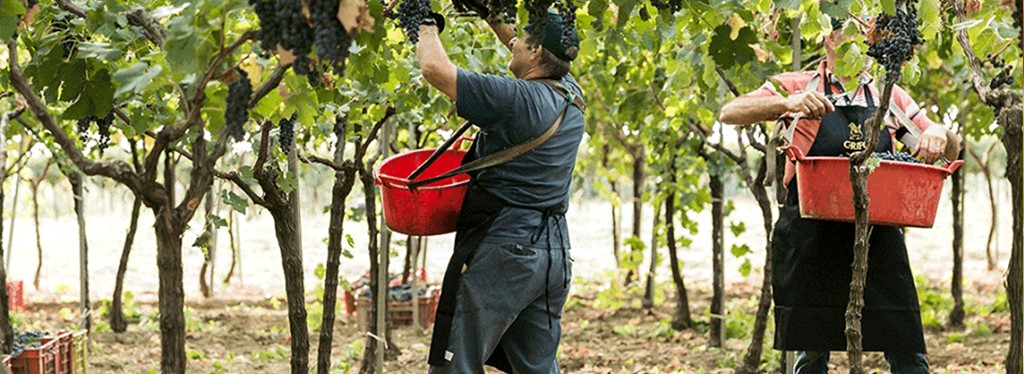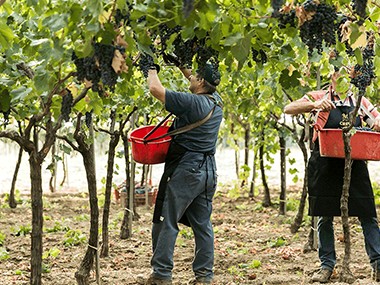
There are 5 native vines cultivated and selected by Cantina di Ruvo di Puglia. These are some of the most important varieties of Puglia: the autochthonous Nero di Troia, Bombino Bianco, Bombino Nero, Moscatello Selvatico, Pampanuto (or Verdeca).
With these Apulian vines, cultivated a few kilometers from Castel del Monte, Cantina di Ruvo di Puglia produces the wines of its most renowned labels, presented in the Crifo range.
Let’s discover the characteristics of these cultivars and the peculiarities of the wines made from their grapes.
Nero di Troia is the top grape of the Crifo production: it is the third autochthonous Apulian grape, after Primitivo and Negramaro, for the cultivated hectares, it boasts origins that are lost in legend and gives a monovarietal wine among the most aristocratic of Puglia.
It is a black-berried autochthonous grape variety, typical of Alta Murgia and Foggia, which according to the area of cultivation, takes on different characteristics. Its berries have an intense ruby color, very dark. The result is a wine for connoisseurs, perfect for aging, also and above all thanks to the natural endowment of polyphenols.
In the last century it experienced a period of great commercial success and was exported in bottles even in France. After an oblivion period, Nero di Troia has been “rediscovered” by Apulian winemakers and is now a symbol of the territory. The wine has an intense ruby red color, a finely tannic taste, austere, spicy with aromas of blackberry and licorice that evolve, over time, in notes of China calissaia.
Bombino Bianco is another important native Apulian grape, whose grape is characterized by low vigor but good productivity.
It prefers dry, light, siliceous or calcareous soils, positioned in hilly altitude and well exposed to the sun. Bombino Bianco must be pruned at medium length in order not to weaken the plants, due to the considerable size of the bunches.
Vinified alone, it produces a straw-yellow wine, with a rich and pleasant aroma and a slightly mineral taste with hints of almonds, anise and a hint of apricot and tropical fruits.
Bombino Nero is the third autochthonous grape variety in the selection of the Apulian grape varieties, cultivated and vinified by Cantina di Ruvo di Puglia. This black grape variety is known for its great vigor, productivity and yield in must, so much so as to be called, in ancient times, “Buonvino”. Its berries are rather large and spheroidal and have a thick skin tending to blue. The ripening is late and the freshly picked berries tend to have high acidity and low sugar levels. It is a very suitable cultivar for vinification in rosé. The result is a pleasantly dry and well-rounded wine.
It has greater sapidity and freshness than other rosè wines as the soil of the Murgia is predominantly calcareous. Its dominant aromas recall roses, citrus, red fruits such as strawberry and raspberry, and pomegranate.
Moscatello Selvatico has a medium-small, orbicular, tri or pentalobate leaf vine, with a medium-sized, conical-cylindrical cluster. The berry is medium-large, with a bright green skin and a good consistency.
It is a very sweet aromatic grape. The resulting wine has a straw yellow color, with a fragrant and musky aroma. The taste is fresh, delicate and typically aromatic. It has hints of candied orange, chamomile, Renetta apple and cotton candy, “spread out” on an aromatic herbaceous carpet. Citrus and delicate orange blossoms return to the taste. Rich and fresh fruity trail in the finish.
Fifth grape variety of Crifo’s selection is Pampanuto, also known as Verdeca.
Also this vine has medium-sized, orbicular leaves. The clusters appear medium in size too and conical in shape, with medium-sized berries, round and with abundant plum on the thick skin. The color is yellow tending to green.
Verdeca stands out for her excellent yields in must, her vigor and good productivity. It is a strong vine, resistant to adverse climate and prefers soils rich in clay. In particular it makes good in the hills of a height between 200 and 400 meters.
The wines obtained in purity are light, neutral, with a strong acidic shoulder. They have a straw yellow color with greenish reflections. The taste is full, with an aromatic bouquet of orange blossom, a hint of sage, white melon, apricot, cardamom and toasted hazelnut. It reflects the nose and ends with a prolonged fresh-savory sensation.
